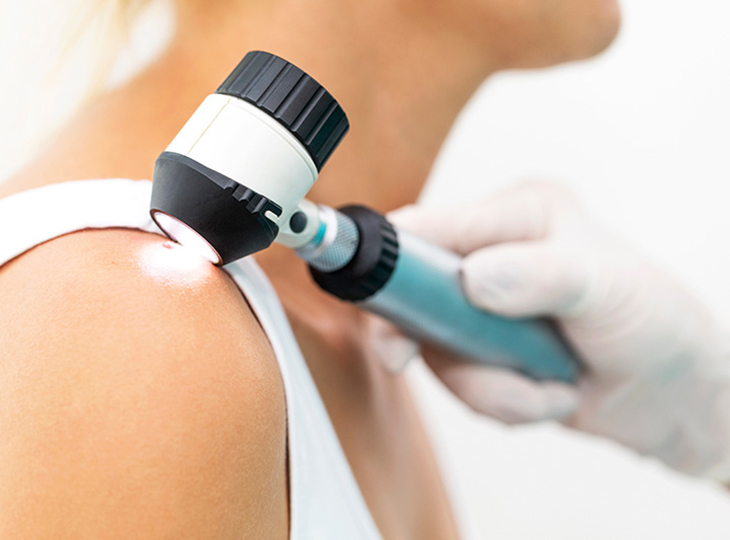Tues: 8:30am - 3:00pm
Wed: 12:00pm - 6:00pm
Thurs: 8:30am - 3:00pm
Fri: Closed
Sat: 8:30am - 12:30pm
Sun: Closed
Greenvale, NY 11548
Skin Cancer: Early Detection


Skin cancer is the most common type of cancer in the world. About 20% of the population, or 1 in 5 people, will be diagnosed with the disease by age 70, according to The Skin Cancer Foundation.
Here’s a more comforting statistic: 99% percent of all skin cancers are curable if they are diagnosed and treated early enough. That’s the key, early detection.
Left untreated, skin cancer can be deadly. Statistically, more than two people in the United States die every hour from skin cancer. Having as few as five sunburns in your lifetime doubles your risk for developing melanoma, the most serious form of skin cancer. Even patients who survive the disease may be disfigured by the medically necessary removal of cancerous skin.
There is good news. Unlike many other forms of disease, skin cancer is a condition that’s readily visible. You can learn the signs and conduct a basic skin cancer exam at home, following up with a dermatologist whenever you have concerns.
Early detection can save your life. Once you know what to watch for, check your body at least once a month and talk to your dermatologist if you see anything suspicious, have a family history of cancers or if you spend a lot of time outdoors.
To begin, look over your body, using a mirror to examine your back and other areas that may be harder to see (or recruit a partner or spouse to help you). Make a note of any moles, freckles and spots. This will help you notice any changes that occur over time.
Know your ABCDEs: Asymmetry, Border, Color, Diameter, Evolution
The ABCDE system is an easy way to remember what you’re looking for when examining your skin. Common moles look much differently than skin cancer.
Skin cancer spots are not shaped perfectly. This makes them asymmetrical. Uniformly round spots are less likely to be cancerous.
Borders. Melanomas often have borders that are irregular in shape and thickness.
Color. Skin cancer spots usually appear in more than one color or shade. Benign spots are more likely to have a consistent color.
Diameter. Melanoma growths, in addition to their asymmetrical shape, are often larger than non-cancerous spots. Watch out for spots larger in diameter than a pencil eraser or any spots that are becoming larger.
Evolution. Be on the lookout for changes in the size, shape and color of skin spots.
If you notice any of the ABCDEs, make an appointment right away with your dermatologist. Remember, early detection saves lives.
Other changes to watch out for include the following:
Sensation. Itching is a common early symptom. There may also be tenderness or even pain around the spot.
Changing or spreading color. If skin coloration begins to spread or changes in appearance, that is a sign of possible melanoma growth.
Elevation. When a bump or mole on your skin rises or begins swelling.
Surface. Watch for spots that change from smooth to scaly or begin oozing. This is often an indicator of possible disease.
If you notice any of these symptoms, schedule an appointment with your dermatologist right away. Preventive medicine is also a good policy. Even if you don’t see any of the warning signs for skin cancer, regular visits with your dermatologist can help with early detection, which increases the success rate if treatment is needed. Based on your lifestyle and habits, your dermatologist can help determine how often you should have a check-up.
Protecting yourself from skin cancer
One of the easiest things you can do to lower the risk of skin cancer is to manage the time you spend in the sun. Apply a quality sunblock with an SPF (skin protection factor) of at least 15 daily, and SPF 30 when spending extended periods of time outside. Reapply after swimming.
While many people associate tanning with a “healthy glow” it is actually quite the opposite. That glowing skin is evidence of damage as a result of overexposure to UV radiation.
Avoid tanning salons and tanning beds. The UV radiation from this equipment is just as strong as the sun and more consistent, because the sun may occasionally be obscured by cloud cover when you’re out sunbathing.
Controlled medical studies over the last 20 years have shown consistently that individuals who visit tanning salons more than once a month are 75% more likely to develop malignant melanoma. If that’s not enough, indoor tanning accidents and burns send more than 3,000 people to the emergency room each year, according to the Centers for Disease Control (CDC).
Before heading outdoors, especially during the summer months, the CDC recommends checking the UV Index in your location. The daily index is usually posted on the websites of local TV stations and weather apps that you can download to a smartphone (you may have this function already built into your phone).
If the UV index is 3 or higher in your area, protect your skin from too much exposure to the sun. Here’s what you can do:
- Stay in the shade.
- Wear clothing that covers your arms and legs.
- Wear a hat with a wide brim to shade your face, head, ears, and neck.
- Wear sunglasses that wrap around and block both UVA and UVB rays.
- Use a broad spectrum sunscreen with a sun protection factor (SPF) of 15 or higher.
Let Walk-in Dermatology Take Care of You
If you have concerns about any skin condition, including concerns about possible skin cancer, you don’t have to wonder, worry or wait. Walk-in Dermatology is here to keep you healthy. Our team of dermatologists and experienced medical staff will address your concerns and provide the necessary care for all your skin conditions. We can set up a Video Visit and even prescribe medications remotely, or you can schedule an appointment with us online. The choice is yours. But don’t wait until the problem gets worse. Contact us today.








